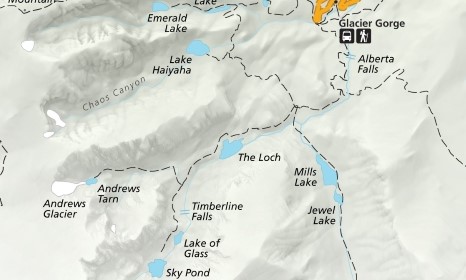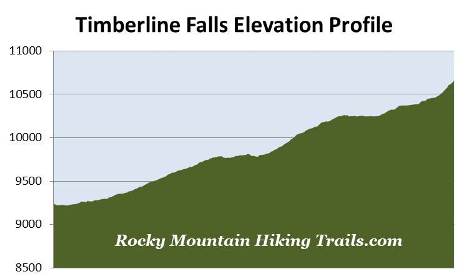

Timberline Falls
| Trail Features: | Waterfalls, Outstanding Lake Views | 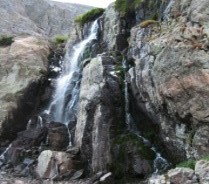 |
|||
| Trail Location: | Glacier Gorge | ||||
| Roundtrip Length: | 8.1 Miles | ||||
| Trailhead Elevation: | 9240 Feet | ||||
| Total Elevation Gain: | 1510 Feet | ||||
| Avg. Elev Gain / Mile: | 373 Feet | ||||
| Highest Elevation: | 10,660 Feet | ||||
| Trail Difficulty Rating: | 11.12 (strenuous) | ||||
| Parking Lot Latitude | 40.31035 | ||||
| Parking Lot Longitude | -105.64038 | ||||
Trail Description:
The hike to Timberline Falls in Rocky Mountain National Park begins from the Glacier Gorge Trailhead, located on Bear Lake Road almost 8 miles from the turn-off at Highway 36. Due to the extreme popularity of the Bear Lake Road area you may want to consider using the free park shuttle to reach the trailhead during peak tourist season. Hikers will also have the option of starting their hike from the Bear Lake Trailhead. This will add another two-tenths of a mile to your overall roundtrip mileage.
Roughly one-quarter of a mile from the parking area, just after crossing Chaos Creek, the trail briefly converges with the Glacier Creek Trail. After walking a very short distance the Glacier Creek Trail splits off to the right and heads toward Bear Lake. To continue towards Timberline Falls hikers should turn left at this junction.
At just over eight-tenths of a mile hikers will reach Alberta Falls, one of the more popular hiking destinations in Rocky Mountain National Park. This scenic 30-foot waterfall thunders down a small gorge on Glacier Creek, and is named after Alberta Sprague, the wife of Abner Sprague, one of the original settlers in the Estes Park area.
The next section of trail, between Alberta Falls and Mills Junction, was rehabilitated by the National Park Service and the Rocky Mountain Conservancy as part of a major, multi-year project that was completed in 2012.
At 1.6 miles hikers will arrive at the North Longs Peak Trail junction. To continue towards your destination hikers should turn right here.
About a half-mile further up the trail you'll reach Mills Junction. The trail to the left leads to Mills Lake and Black Lake, while the trail to the right leads to Lake Haiyaha. As part of the same trail rehabilitation project, this unimproved route was also upgraded in an effort to make it safer and easier to follow as it travels towards the lake.
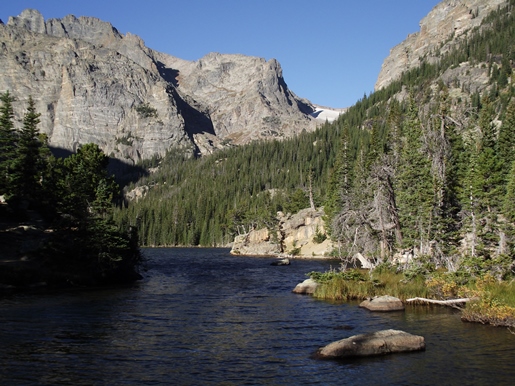 To continue towards Timberline Falls hikers should proceed straight ahead onto the Loch Vale Trail.
To continue towards Timberline Falls hikers should proceed straight ahead onto the Loch Vale Trail.
Above the junction the route becomes quite steep as it climbs over a couple of short switchbacks through a fairly impressive gorge, while Icy Brook cascades down the valley on your left. On the third switchback you'll reach a vantage point that offers a nice view of a waterfall tumbling down the gorge.
At roughly 2.8 miles hikers will reach Loch Vale, better known as The Loch. This beautiful subalpine lake, situated at 10,190 feet, is located within one of the most studied watersheds in the world. For more than forty years scientists have monitored chemical inputs into the watershed, from wind and precipitation, in order to distinguish between human impacts and natural processes occurring in this environment.
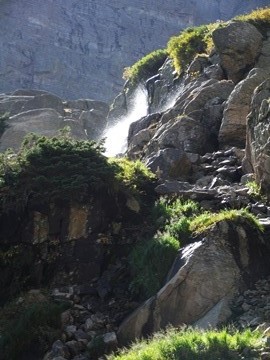 Dominating the views directly across the foot of the lake is 13,153-foot Taylor Peak and Taylor Glacier. Framing the gorge on either side is 12,668-foot Thatchtop Mountain and The Sharkstooth. As you proceed around the north shore of the lake 13,208-foot Powell Peak will begin to reveal itself towards the south.
Dominating the views directly across the foot of the lake is 13,153-foot Taylor Peak and Taylor Glacier. Framing the gorge on either side is 12,668-foot Thatchtop Mountain and The Sharkstooth. As you proceed around the north shore of the lake 13,208-foot Powell Peak will begin to reveal itself towards the south.
The word "Loch" is the Scottish Gaelic and Irish term for a lake or a sea inlet.
Beyond the lake the trail begins to climb again, and at just over 3.6 miles you'll arrive at the Sky Pond / Andrews Glacier split. The trail to the right leads to Andrews Glacier and the Andrews Creek Backcountry Campsite, the only campsite in this area. To continue on towards Timberline Falls hikers should stay to the left at this junction.
Roughly one-third of a mile above the junction you'll enjoy your first good view of Timberline Falls, high above the trail. From this vantage point the trail begins to climb a series of rock steps. The optimal word here will be "gasp," as you'll be gasping for air during this next stretch of trail, which climbs roughly 200 feet in just 0.15 miles.
At just over 4 miles from the trailhead hikers will reach the base of Timberline Falls. The main portion of the waterfall drops roughly 100 feet, and continues cascading down the valley below you. Be sure to look out across the valley for a birds-eye view of The Loch in the far-off distance.

While looking at a park map you might think that it's a relatively easy walk from the falls to the Lake of Glass or Sky Pond. An on-site inspection, however, reveals just how rough the terrain actually is around the waterfall.
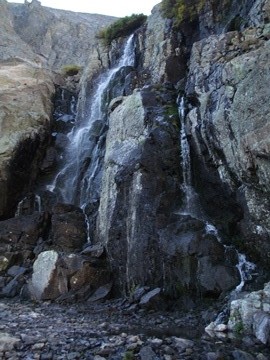
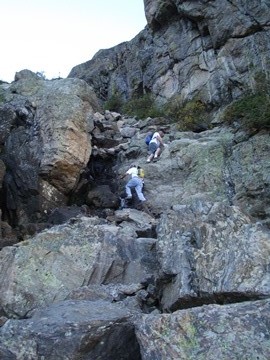
From the base of the waterfall the trail continues up a chute to the right of the falls. This is a fairly challenging scramble that climbs roughly 100 feet, and requires hand holds and the use of all four limbs while ascending. The first 30 feet or so are the most difficult, but beyond that it's a relatively easy scramble. Just to complicate things a little more, portions of the climb may have water flowing down the route. I'm not sure where you cross the threshold from hiking to mountaineering, and the climb up to the Lake of Glass may not cross that line, but it sure does approach it. It's nothing exceedingly dangerous, but you will have to take your time and be extremely cautious. If you have a fear of heights you may want to think twice about proceeding any further. Also, if rain or snow is imminent, it would not be wise to continue beyond this point.
